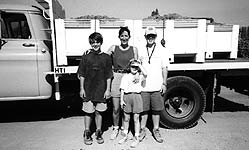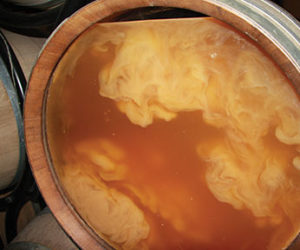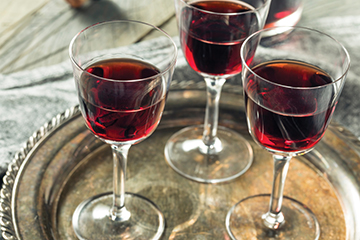 Ask most home winemakers where to find America’s best wines, and they will probably say California. Ask for the best region, and they will almost certainly say Napa Valley.
Ask most home winemakers where to find America’s best wines, and they will probably say California. Ask for the best region, and they will almost certainly say Napa Valley.
And if you follow the Napa River into an area that three hundred residents call home, you will have reached a winemaker’s Nirvana: Rutherford. This California appellation sits in the heart of the beautiful Napa Valley, consists of well-drained soil and enjoys a beautiful climate of hot days and cool nights.
Rutherford residents can hardly avoid the winemaking bug. Napa Valley native Cheryl Emmolo was even more susceptible than most. Her grandfather started a rootstock nursery in the valley in 1923, and the family has owned a 51-acre vineyard in Rutherford for more than 70 years. Include her former 15-year marriage to Chuck Wagner, winemaker at Caymus, and it’s obvious that Cheryl Emmolo was born and raised to make wine.
Birth of a Winery
Nineteen ninety-four marked the beginning of Emmolo Vineyards. Recently divorced, Emmolo had been toying with the idea of starting a business, but she was looking for something that would leave time for her three children, now ages 19, 17 and 11. Given her family background, a private wine label seemed the perfect choice. She spent months reaching the final decision and announced her plans to her children on Mother’s Day, pointing out that the winery would be a family thing. “My kids come first in my life,” she says, “and I wanted this to be something we could share.”
The kids agreed, so the project was a go. “I felt really confident in my ability to do it,” she says. “I asked my dad if I could buy my grapes from him. He said yes and the rest is history.”
Emmolo started small, producing only 400 cases in her first year. Volume has grown slowly but steadily over the years, with annual output now touching 1,100 cases.
The vineyard, comprising 43 acres on the alluvial fan that extends westward from the Napa River, produces two varietals. The Sauvignon Blanc is Emmolo’s big seller, accounting for 75 percent of annual sales. The wine is a pale, straw color and the aroma is heady, with fresh melon, figs, and a touch of flintiness. The Sauvignon Blanc spends eight months in oak barrels, which adds a toasty dill character. The Merlot, by comparison, sells nicely but is limited to an annual supply of roughly 300 cases. “Most of dad’s grapes are contracted out until 2002,” says Emmolo. “So for the time being, I can produce only a limited amount of wine.”
But, as Cheryl points out with a chuckle, she has turned that hurdle into an advantage. She calls her seven rows of Sauvignon Blanc “the best in the vineyard” and bubbles about the quality of her father’s Merlot grapes. The wine spends 14 months in oak barrels and offers big cherry aromas beautifully enhanced with forward fruit flavors.
Emmolo has her grapes custom-crushed, fermented, aged and bottled at Rutherford Grove, a nearby winery that provides contract winemaking services. She works in close conjunction with veteran Napa winemaker Bob Pepi to produce wines that fit her vision.
Top Tips from Emmolo’s Pro
Emmolo admits that she knows little about making wine. But she knew enough to hire a first-rate winemaker. Bob Pepi, the son of famed winemaker Robert Pepi, has been making wine for nearly two decades. His career started with the 1980 harvest, and by the next year he was making wine and managing his father’s operation. In 1991, he jumped to Conn Creek winery, but left in 1995 to start a consulting business. “I travel between North and South America, making wine in both hemispheres,” he says. “It’s like the winemaker’s dream. I get to participate in two harvests each year, since South America harvests its grapes in February and March.”
Pepi calls his winemaking relationship with Emmolo Vineyards “natural,” saying that he and Emmolo share the same visions for her finished product. “We both felt the wines should have a concentrated fruit quality with a hint of new oak,” he explains. “Her Sauvignon Blanc grapes are perfect because they have excellent fruit complexities. And we carefully manage our oak barrels, putting one-third of the wine in new oak, one-third in second-year barrels and one-third in third-year barrels.”
Pointing to the success of Emmolo Vineyards and each of its excellent harvests, Pepi says grape quality is the first key to winemaking success. But finding excellent grapes means more than just buying from a quality operation. His top tips for home winemakers begin with the palate.
Pepi Says: Taste Good Grapes
“It’s a learning process,” he says. “The more you taste good grapes, the more you’ll learn to taste the concentrated fruit. I suggest traveling to vineyards and walking through the rows, sampling grapes as you go. You’ll soon discover that some have explosive flavors, while others are bland. And then you’ll learn to pick the excellent ones by sight alone.”
Once you locate the perfect grape, Pepi suggest you let them hang on the vine as long as possible. “The bottom line is simple: More time on the vine brings the grape to its height of flavor.”
For those who make wine from concentrate, Pepi suggests a similar approach. Insist upon a product that is bright and fresh both in color and flavor. If possible, sample it for clean, fruit characteristics and reject any products that have a port, raisin-like flavor.
Pepi Says: Study Fine Wines
Pepi recommends that you build your knowledge before jumping into home winemaking. Comparative wine tastings are a great place to start. If you plan on making Sauvignon Blanc, for example, buy several bottles from different vineyards and do some side-by-side tastings. This will train your palate, while helping you determine your ultimate winemaking goals.
You should also bolster your knowledge of chemistry, says Pepi. A good winemaking book should help you understand basic concepts like “total acidity,” which measures all the acid in wine, and pH, which is used to measure the acid in wine that registers on the palate. You should also learn to measure sulfur dioxide, which prevents oxidation and bacterial activity but can hurt your wine when misused.
Pepi Says: Get Clean
“I don’t care if you’re the best winemaker in the world,” says Pepi. “If your cellar isn’t clean, your wine will go bad.” Pepi estimates that 80 percent of great winemaking is cleanliness, and he doesn’t mean only that you must have a sparkling kitchen. Every piece of equipment that is used to crush, transfer, stir and store your wine must be as clean as possible. Should you ignore this advice, prepare for some truly awful wine.
Here is Pepi’s six-step process to sanitize your home winery.
- Clean your equipment. Any household soap will do, but use a scrub brush to attack stains and grime. Even a speck of surface may harbor wine-killing bacteria.
- Rinse with water, taking care that the soap residue is removed.
- Sanitize with bleach. That’s right: regular household bleach. “This does a great job of killing bacteria,” says Pepi. And don’t worry about residual bleach, since the next steps take care of that.
- Thoroughly rinse with water.
- Rinse with citric acid. This neutralizes residual soap or bleach.
- Finish with a water rinse.
Pepi Says: Ferment Well
Home winemakers must often face a bitter reality: Your equipment limits your winemaking abilities.
This is especially true with fermentation. White wine likes to ferment between 55° to 60° F (18° to 21° C), while red wine ferments best between 80 to 90° F (27° to 32° C). Home winemakers can do fine with the higher temperatures – almost any room in your house will let a fermenting wine reach these temperatures naturally. But holding a fermentation temperature down in the lower ranges is a difficult task without proper equipment.
For those who want to make white wine, your best tool is an old refrigerator. Any retired Frigidaire will hold a five-gallon (18.9 L) carboy, and it might even hold two if you manage the space effectively. Be sure you carefully monitor the refrigerator’s internal temperature. Too low is as bad as too warm, since low temperatures impede fermentation. Consider installing a new thermostat.
Of course, managing fermentation goes beyond temperature. For red wines you must regularly punch down the skins to extract color and flavor from the grapes. “I do most punching-down at the beginning of fermentation,” says Pepi. “I do it four to six times per day in the first days, and once a day at the end.”
With white wines, meanwhile, you want to remove the juice from the skins and stems as quickly as possible. Failure to do so may result in bitter qualities in the finished wine. “And when you crush white wine grapes, throw them in, stems and all,” he says. “Some of the best white wines out there are whole cluster-pressed.”
Pepi Says: Have Fun!
Sometime in the not-so-distant future, you’ll enjoy that first sip of Emmolo-inspired wine. Perhaps it will be fantastic, perhaps horrible. Whatever your taste buds tell you, remember Pepi’s final tip: Have fun!






